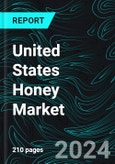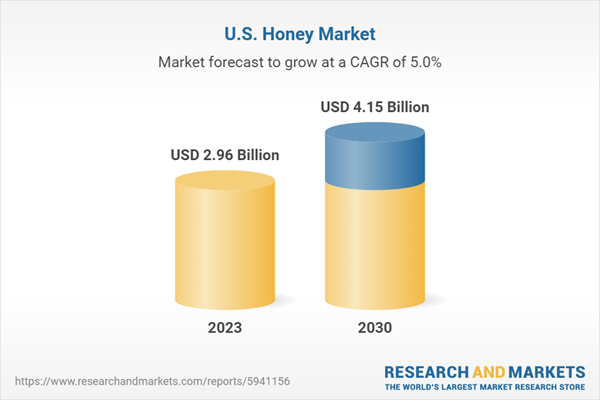United States Honey Market is expected to increase at a CAGR of 4.95% between 2024 and 2030
The surge in fitness awareness fuels the growth of the honey market as purchasers increasingly prioritize natural and healthy alternatives to processed sugars. Honey, lauded for its dietary benefits and medicinal properties, emerges as a favored desire for fitness-aware individuals to enhance their well-being. Its rich antioxidant content, antimicrobial properties, and capability of relieving allergic reactions contribute to its enchantment. As the focus on the fitness benefits of honey continues to spread, the demand for this natural sweetener escalates, leading to the expansion of the United States honey market.The United States honey market is updating, adapting to diverse effects such as technological betterment and transforming consumer possibilities. Introducing new processing technology and revolutionary extraction techniques has increased production performance and yield. According to the USDA, US honey production amounted to one hundred twenty-five million pounds. The yield per colony averaged 47.0 pounds. There had been 2.67 million colonies making honey. Furthermore, there's a developing trend in the direction of natural and specialty honey, pushing the enterprise into new market segments even as it expands its worldwide footprint.
The honey market has several untapped capacities that individuals can leverage. Producers of prescription drugs can explore honey's healing properties to achieve growth. Implementing strict measures against honey adulteration will enhance credibility. This can also lead to an increase in worldwide change. For example, the USDA's ELAP application gives monetary help to honeybee producers for losses caused by disease, adverse climate events, blizzards, and wildfires. Also, the U.S. General Services Administration (GSA) introduced its Pollinator Initiative in 2022 to shield pollinators, which can be critical to agriculture and food manufacturing, contributing over US$ 20 Billion annually to the country's broad economy. This is part of GSA's commitment to sustainability and addressing climate change. Hence, the United States honey market was US$ 2.96 Billion in 2023.
Honey holds significant importance in the food and beverage industry of the United States
By application, the United States honey market is fragmented into Food & Beverage, Personal Care & Cosmetics, Pharmaceuticals, and Others. Food and beverages are among the most prominent applications in the United States honey market. This is due to honey's versatility and natural appeal. As a wholesome sweetener, it enhances the flavor profiles of myriad merchandise, from breakfast cereals to baked goods, sauces, and dressings. Its flavor and nutritional benefits make it a favored ingredient for health-conscious purchasers searching for natural alternatives to processed sugars. Moreover, honey's antimicrobial properties extend its shelf life in food items, contributing to its substantial use throughout the food and beverage industry, thereby driving the dominance of the honey market in the United States.Glass jars may become the preferred choice in the United States honey market
The United States honey market is segmented by packaging into glass jars, bottles, Tubs, tubes, and others. Glass jars could dominate the United States honey market. This is because they hold honey's purity, stopping infection and keeping its natural flavors. The apparent nature of glass lets consumers assess honey quality, fostering belief visually. Moreover, glass is eco-friendly and recyclable, aligning with developing environmental worries. The aesthetic appeal of glass jars complements product presentation, influencing purchaser alternatives. Overall, the combination of renovation, transparency, environmental consciousness, and visual enchantment makes glass jars a primary need in the US honey market.Conventional processing is one of the most significant segments of the honey market in the United States
The United States honey market is categorized into Organic and Conventional by processing. Conventional processing has one of the most noteworthy shares in the US honey market. This is due to its accessibility, familiarity, and cost-effectiveness. This technique entails heating honey to dissolve crystals and improve readability, followed by filtration for particle elimination. While critics argue this process may additionally reduce some of honey's natural enzymes and antioxidants, it keeps consistency and extends shelf lives. Moreover, traditional processing aligns with regulatory standards, ensuring product protection and compliance. Its massive adoption through large-scale manufacturers and smaller beekeepers solidifies its function as a dominant processing section in the United States honey market.Honey market in the US majorly relies on supermarkets and hypermarkets
By distribution channel, the United States honey market is branched into Supermarkets/Hypermarkets, Convenience Stores, Online Retailers, and Others. Supermarkets and hypermarkets command one of the principal shares of the United States honey market. This is because of their widespread reach and comfort for consumers. These retail giants offer numerous honey kinds, catering to one-of-a-kind tastes and preferences. Supermarkets and hypermarkets are the go-to locations for people shopping for honey because they are readily handy and low-priced. They are found in urban and rural regions, making them a widespread consumer desire. This has given them a decisive US honey market function.California might dominate the honey market in the United States
By states, the United States honey market is divided into California, Texas, New York, Florida, Illinois, Pennsylvania, Ohio, Georgia, New Jersey, Washington, North Carolina, Massachusetts, Virginia, Michigan, Maryland, Colorado, Tennessee, Indiana, Arizona, Minnesota, Wisconsin, Missouri, Connecticut, South Carolina, Oregon, Louisiana, Alabama, Kentucky, and Rest of United States. California may become a frontrunner in the United States honey market. This is because of its numerous agricultural landscapes and favorable climate for honey manufacturing. The country's vast expanses of farmland support an extensive selection of floral resources, imparting considerable nectar for honeybees.California's innovative agricultural practices and research institutions promote innovation in beekeeping strategies, enhancing honey yields and high quality. The honey enterprise in California is flourishing and is renowned for producing terrific honey, such as orange blossom and avocado. This has caused a sturdy demand from domestic and worldwide markets, cementing its role as a widespread participant in the US honey market.
Key Players
Comvita Limited, Barkman Honey, LLC, Johnston Home, Dutch Gold Honey, Adee Honey Farms, The Big Island Bee Company, LLC, Glory Bee Inc., Crockett Honey Co., Inc., and Miller's Honey Company are the leading companies in the United States honey market.Application - United States Honey Market breakup in 4 viewpoints:
1. Food & Beverage2. Personal Care & Cosmetics
3. Pharmaceuticals
4. Others
Packaging - United States Honey Market breakup in 5 viewpoints:
1. Glass jars2. Bottles
3. Tubs
4. Tubes
5. Others
Processing - United States Honey Market breakup in 2 viewpoints:
1. Organic2. Conventional
Distribution Channels - United States Honey Market breakup in 4 viewpoints:
1. Supermarkets/Hypermarkets2. Convenience Stores
3. Online Retailers
4. Others
States - United States Honey Market breakup of 29 States:
1. California2. Texas
3. New York
4. Florida
5. Illinois
6. Pennsylvania
7. Ohio
8. Georgia
9. New Jersey
10. Washington
11. North Carolina
12. Massachusetts
13. Virginia
14. Michigan
15. Maryland
16. Colorado
17. Tennessee
18. Indiana
19. Arizona
20. Minnesota
21. Wisconsin
22. Missouri
23. Connecticut
24. South Carolina
25. Oregon
26. Louisiana
27. Alabama
28. Kentucky
29. Rest of United States
All the Key players have been covered from 3 Viewpoints:
- Overview
- Recent Development
- Revenue Analysis
Company Analysis:
1. Comvita Limited2. Barkman Honey, LLC
3. Johnston Home
4. Dutch Gold Honey
5. Adee Honey Farms
6. The Big Island Bee Company, LLC
7. Glory Bee Inc.
8. Crockett Honey Co., Inc.
9. Miller's Honey Company
Table of Contents
Companies Mentioned
- Comvita Limited
- Barkman Honey, LLC
- Johnston Home
- Dutch Gold Honey
- Adee Honey Farms
- The Big Island Bee Company, LLC
- Glory Bee Inc.
- Crockett Honey Co., Inc.
- Miller's Honey Company
Methodology
In this report, for analyzing the future trends for the studied market during the forecast period, the publisher has incorporated rigorous statistical and econometric methods, further scrutinized by secondary, primary sources and by in-house experts, supported through their extensive data intelligence repository. The market is studied holistically from both demand and supply-side perspectives. This is carried out to analyze both end-user and producer behavior patterns, in the review period, which affects price, demand and consumption trends. As the study demands to analyze the long-term nature of the market, the identification of factors influencing the market is based on the fundamentality of the study market.
Through secondary and primary researches, which largely include interviews with industry participants, reliable statistics, and regional intelligence, are identified and are transformed to quantitative data through data extraction, and further applied for inferential purposes. The publisher's in-house industry experts play an instrumental role in designing analytic tools and models, tailored to the requirements of a particular industry segment. These analytical tools and models sanitize the data & statistics and enhance the accuracy of their recommendations and advice.
Primary Research
The primary purpose of this phase is to extract qualitative information regarding the market from the key industry leaders. The primary research efforts include reaching out to participants through mail, tele-conversations, referrals, professional networks, and face-to-face interactions. The publisher also established professional corporate relations with various companies that allow us greater flexibility for reaching out to industry participants and commentators for interviews and discussions, fulfilling the following functions:
- Validates and improves the data quality and strengthens research proceeds
- Further develop the analyst team’s market understanding and expertise
- Supplies authentic information about market size, share, growth, and forecast
The researcher's primary research interview and discussion panels are typically composed of the most experienced industry members. These participants include, however, are not limited to:
- Chief executives and VPs of leading corporations specific to the industry
- Product and sales managers or country heads; channel partners and top level distributors; banking, investment, and valuation experts
- Key opinion leaders (KOLs)
Secondary Research
The publisher refers to a broad array of industry sources for their secondary research, which typically includes, however, is not limited to:
- Company SEC filings, annual reports, company websites, broker & financial reports, and investor presentations for competitive scenario and shape of the industry
- Patent and regulatory databases for understanding of technical & legal developments
- Scientific and technical writings for product information and related preemptions
- Regional government and statistical databases for macro analysis
- Authentic new articles, webcasts, and other related releases for market evaluation
- Internal and external proprietary databases, key market indicators, and relevant press releases for market estimates and forecasts

LOADING...
Table Information
| Report Attribute | Details |
|---|---|
| No. of Pages | 210 |
| Published | February 2024 |
| Forecast Period | 2023 - 2030 |
| Estimated Market Value ( USD | $ 2.96 Billion |
| Forecasted Market Value ( USD | $ 4.15 Billion |
| Compound Annual Growth Rate | 4.9% |
| Regions Covered | United States |
| No. of Companies Mentioned | 9 |









